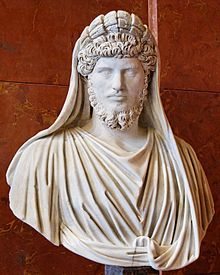Arval Brothers
The Arval Brothers (lat. Fratres arvales ) were a Roman college of twelve priests . Its original meaning is "Gebrüder des Ackers" ( arvum , field, field '). They were the priests of the otherwise unknown Roman goddess Dea Dia , a fertility goddess.
The cult is very old and was hardly understandable even in the times of the Roman Republic . Originally the twelve priests are said to have been sons of Acca Larentia , who was a lover of Hercules and wife of Faustulus and nurse of Romulus . The records of the ritual acts ( acta ) are partially preserved in writing . It is known that iron and vessels turned on the potter's wheel were forbidden in the sacred grove on the Via Campana. A cult song addressed to Mars ( Carmen Arvale ) by the Arval brothers begins with the words ENOS LASES IUVATE - “Help us, Laren ”. The corresponding dance mentioned in the text, the triumpus (three step), was also danced in the triumphal procession , which owes its name to it. In addition to ancient gods such as Dea Dia and the spring god Fons , the Capitoline Triassic was sacrificed.
The college originally consisted only of patricians who chose a magister (teacher) as spokesman. Beside him worked the flamen , a particularly prominent priest. Membership was lifelong and was supplemented by co-option .
After the cultic association was hardly of importance in the republican times, it was by Augustus 27 BC. Revived and entrusted with tasks related to the imperial cult . The Arval brothers now also sacrificed for their well-being on the emperor's commemoration days. The emperor and his friend Agrippa were among the first members of the newly established priesthood. The Arval brothers were now (pre) selected by the emperor and made their vows before the imperial family. Membership was no longer restricted to patricians. The emperors and individual members of their families were members of the college. B. Tiberius Iulius Caesar Nero , called Gemellus, who was later murdered by Caligula as a competitor for the throne. Only at the end of the third century did the cult lose its importance again. The Fasti sacerdotum named an Arval brother named Annius Rufus for the last time in 307.
literature
- Babett Edelmann: Arval Brothers and Imperial Cult. On the topography of the Roman imperial cult. In: Hubert Cancik (Ed.): The practice of worshiping rulers in Rome and its provinces . Mohr Siebeck, Tübingen 2003, pp. 189–205, ISBN 3-16-147895-9 .
- Jörg Rüpke , Bernd Nüsslein, Helmut Pannke: Fasti sacerdotum: the members of the priesthoods and the sacred functional staff of Roman, Greek, Oriental and Judeo-Christian cults in the city of Rome from 300 BC. BC to AD 499 ; 3 volumes, Franz Steiner Verlag, 2005.
- John Scheid : Romulus et ses frères. Le collège des frères arvales, modèle du culte public dans la Rome des empereurs . École Française de Rome, Rome 1990, ISBN 2-7283-0203-0 .
- John Scheid: Le collège des Frères Arvales. Étude prosopographique du recrutement (69–304) . "L'Erma" di Bretschneider, Rome 1990, ISBN 88-7062-679-2 .
- John Scheid, Paola Tassini, Jörg Rüpke : Recherches archéologiques à la Magliana. Commentarii Fratrum Arvalium qui supersunt. Les copies épigraphiques des protocoles annuels de la confrérie arvale (21 av. – 304 ap. J.–C.) . École Française de Rome, Rome 1998, ISBN 2-7283-0539-0 .
- Georg Wissowa : Arvales fratres . In: Paulys Realencyclopadie der classischen Antiquity Science (RE). Volume II, 2, Stuttgart 1896, Sp. 1463-1486.
